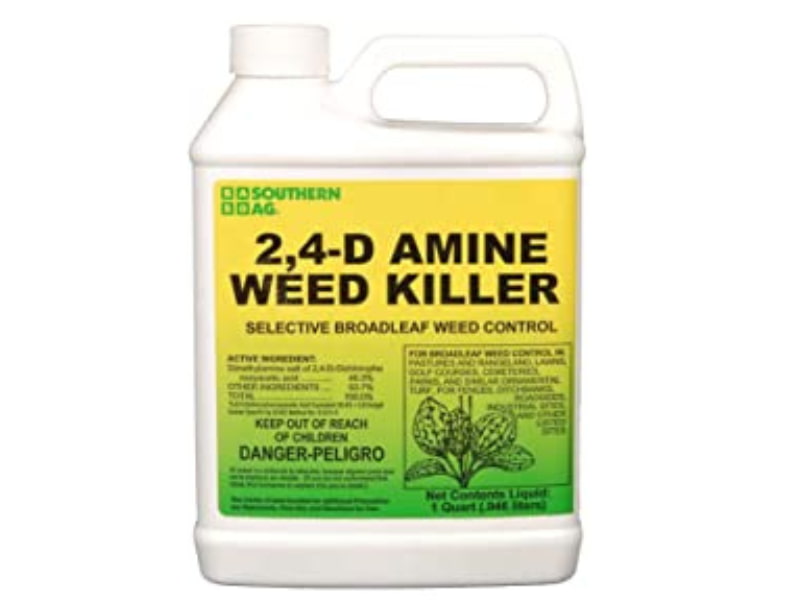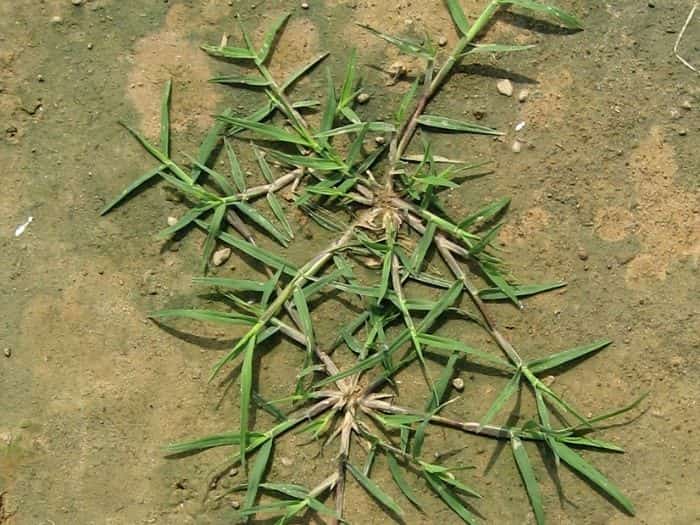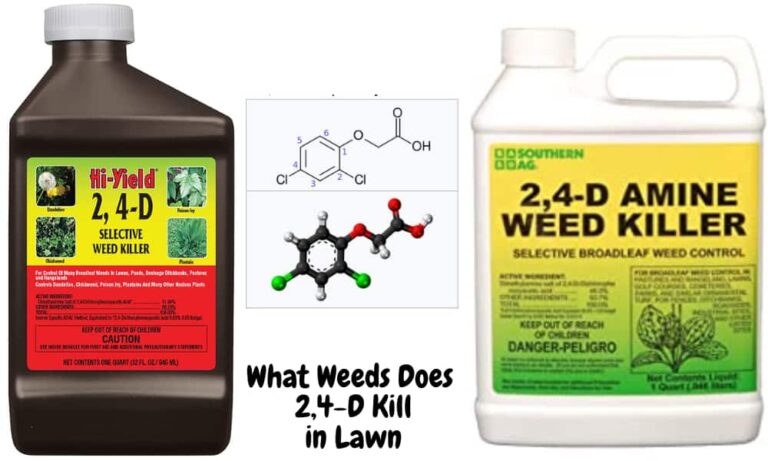2,4-D Mix Ratio, Instructions + How to Mix the Weed Killer
Weed killers containing 2,4-D are popular among lawn care professionals as a reliable option for getting rid of different species of broadleaf weeds. If you’re considering this herbicide, you want to make sure you get the mixing ratio correctly to avoid injury to your lawn. So, what’s the mixing ratio of 2,4D?
For most 2,4-D products, the right mixing ratio is 2.5 oz of the concentrate per 1 gallon of water for killing weeds over 400 sq. ft. of yard. If your lawn is 1000 sq. ft., increase the ratio to 6.25 oz of 2,4-D per 2.5 gallons of water to kill weeds effectively.
You should carefully read the manufacturers’ instructions when using 2,4-D herbicides considering different brands may have different concentrations and application methods that can affect the herbicide’s effectiveness.
What is the 2,4-D Mix Ratio?
The recommended mixing ratio for 2,4-D is 2.5 oz of herbicide to 1 gallon of water. Add five tablespoons of 2,4-D into a gallon of water and mix well before spraying onto broadleaf weeds to kill them.

When I looked at some of the popular labels, I noticed several subtle differences in how you should mix the herbicide. Factors such as weed susceptibility, size of the area in square feet, weather conditions, the growth stage of weeds, and quality of the herbicide are all essential considerations that can affect the quantity of 2,4-D you can apply on your lawn.
2,4-D Mixing Instructions
A product’s chemical formulation, physical appearance (dust, liquid, granules), 2,4-D concentration, and potential environmental consequences all play a role in determining the ideal mixing and application instructions.
Here are the general mixing instructions for 2,4-D:
Mix 2.5 ounces of 2,4-D with 1 gallon of water and spray it over 400 sq. ft. of yard with broadleaf weeds. If the area is bigger, increase the amount of herbicide concentrate and water when mixing. For example, mix 6.25 oz of 2,4-D with 2.5 gallons of water to spray a yard measuring 1000 sq. ft.
- Fill your spray tank with half a gallon of water.
- Add 2.5 ounces of 2,4-D weed killer.
- Add another half a gallon of water into the spray tank.
- Mix well by keeping the agitator running as you add water into the tank.
- Spray the weed killer solution on the weeds over 400 square feet of your yard.
Here’s a table summary of the application rates for lawns:
| Area (square feet) | 2,4-D Mixing ratio |
| 400 sq. ft. | 2.5 oz of 2,4-D per 1 gallon of water |
| 800 sq. ft. | 5 oz 2,4-D per 2 gallons of water |
| 1000 sq. ft. | 6.25 oz 2,4-D per 2.5 gallons of water |
| 1200 sq. ft. | 7.5 oz 2,4-D per 3 gallons of water |
Always remember to read the product guidelines to learn how to use the product correctly. Mixing incorrectly can affect the efficacy and duration it takes for 2,4-D to kill weeds in your lawn.
How much 2,4-D per 25 gallons?
Mix 62.5 oz of 2,4-D concentrate per 25 gallons of water in the sprayer. If you’re using a 25-gallon sprayer and would like to fill the whole tank with the mixed herbicide, ensure you’re going to cover a weedy area that’s at least 10,000 square feet.
If you cover a smaller area with that much herbicide, you can easily injure turfgrass and other desired plants you did not intend to target.
Instructions for Different Products
Here are the mixing instructions of a few herbicide brands containing a 2,4-D chemical formula.
Southern Ag Amine Weed Killer
Amine Weed Killer from Southern Ag is a reputable product that contains 2,4-D as a primary compound to control broadleaf weeds. You can apply the herbicide on golf courses, lawns, select pasture, and ornamental turf.
The herbicide contains a 2,4-D liquid concentrate of 3.8lbs per gallon with low volatility. The correct mixing rate includes the application of 2-3 teaspoons of Southern Ag Amine Weed Killer for every 3-5 gallons of water. Ideally, such an amount should cover 1000SqFt.
Southern Ag Amine Weed Killer provides a low-cost solution to broadleaf weeds as you can readily cover an area of about 1 acre with only 1-4 pints of the herbicide. It’s best to use a fan-type coarse, low-pressure spray for optimal effect.
Hi-Yield 2,4-D Selective Weed Killer
The Hi-Yield 2,4-D Selective Weed Killer is a reputable product that can help you deal with different broadleaf weed species such as dandelion, arrowhead, etc.
The product is ideal for lawns, ditches, and grasslands, where its weed-selective features leave out grass and other beneficial non-broad leaf species. Ideally, the mixing ratio is 1:15 (where a gallon of the herbicide is mixed in fifteen gallons of water).
The Manufacturer’s mixing requirements recommend adding ½ the quantity of water to the tank, pouring prescribed amounts of the herbicide before filling the remaining space with water. Spray the concoction evenly over a surface and adjust concentration depending on the weed species sensitivity, ease for control, etc.
For smaller surfaces, a mix of 6-8 teaspoons (3-4 ounces of liquid) can adequately cover a surface range of 1000 Sq.Ft. Hi-Yield 2,4-D Weed Killer pairs perfectly with the Hi-Yield spreader sticker. You can mix both for increased effectiveness (combining the product with other agents might affect the herbicide’s selectiveness and potentially damage separate plant species).
Remember to take the necessary precautions when applying the herbicide as exposure to skin, eyes (or) other sensitive body parts might cause irritation and health issues.
Drexel De-Amine 4 (2,4-D Amine Weed Killer)
Drexel De- Amine 4 is an effective herbicide that predominantly eliminates annual and perennial broadleaf weeds. The product contains a low volatile amine 2,4-D concentrate as a chief chemical in weed control and is ideal for grains, corn, turfgrass, etc.
The product contains a 38.6% acid/ 3.74 lb per gallon predominantly packaged as a liquid concentrate. The producer recommends that you only use water during mixing as additional agents may cause unforeseen crop damage. The ideal mixing ratio is 2.5 ounces of concentrate for every gallon of water (ratios may change depending on equipment choice, weed sensitivity, and intended coverage).
It’s a good idea to first add water to the spray tank up to half full, mix with species quantities of herbicide before filling the remaining space with more water. The product is suitable for use in aquatic environments though you might have to take some extra precautions.
Use a low-pressure nozzle and spray evenly for best results. Drexel De-Amine 4 herbicide can be harmful to dogs, kids, and adults if mishandled. It’s crucial to wear protective attire like eye goggles, long-sleeved shirts, and gloves to safeguard against skin contact which might irritate.
Considerations When Mixing 2,4-D Weed Killer
You might have to take several factors into account when mixing a 2,4-D Weed Killer. Like most acid-based herbicides, 2,4-D weed killers are susceptible to compatibility issues, effects on stressed weeds, environmental consequences, effective dispersal apparatus/equipment, etc.
The most important considerations include:
Type of weeds
2,4-D herbicides mainly deal with broadleaf weeds. When the weeds are younger, you can reduce the herbicide concentration without affecting the product’s effectiveness.
Well-established weeds are much more challenging to eradicate and might require a higher concentration/ several sessions before the weeds die off entirely.
Application method
You can opt for several methods when spraying the herbicide over an affected area. For a small surface, you can use a hand spray, sprayer, etc.
A large tract of land (such as a ranch, farm) requires separate application equipment. Some people use tractors and planes to disperse the herbicide over large swatches of land with broadleaf weeds. An increase in the surface area often increases the quantities of water (in gallons) required.
Water quality
It’s crucial to consider the water quality during mixing. Hard water contains additional compounds that can affect the chemical’s PH and compromise its overall ability to perform optimally.
It’s best to confirm a herbicide’s optimal pH range and adjust the water pH levels accordingly. Some of the popular choices include organic acids and chemical compounds such as Ammonium Sulphate. Water quality can positively or negatively affect the mixing ratio of 2,4-D Weed Killer herbicides.
Can too much 2,4-D kill grass?
Excessive application of 2,4-D herbicide can harm your grass. However, most grass species are resistant to damage from the chemical components responsible for broadleaf control in 2,4-D herbicides. The ideal application period of the herbicide is about once every 30 days.
Continuous application of 2,4-D herbicides causes the chemical to linger in the soil for longer, potentially affecting the grass quality of the affected space.
Can you mix 2,4-D with other herbicides?
It’s not advisable to mix different herbicides, given that some of the combinations might have compatibility issues while others might damage unintended plants.
However, unless the product label prohibits mixing herbicide products of the same crop, you can mix 2,4-D herbicides with other products for increased effectiveness. Examples include mixing 2,4-D herbicides with Glyphosate, Dicamba, etc.
References:

![When to Apply Crabgrass Preventer [Before or After Rain?]](https://lawnmodel.com/wp-content/uploads/2021/03/When-to-apply-crabgrass-preventer-min.jpg)
![Crabgrass Removal Tool [3 Best Weed Pullers for Crabgrass]](https://lawnmodel.com/wp-content/uploads/2020/11/Fiskars-Crabgrass-Removal-Tool.jpg)



Need to kill volunteer maple trees and brush around pond. Is it good for that? Will it hurt fish?
Yes Russ, 2,4-D is effective for controlling maples and other brush around a pond, However take precautions to avoid contaminating the water and harming the fish populations. If it is the only method available, maintain a buffer zone of atleast 15-25 ft from the edge of the pond. Note even if 2,4-D breaks down fairly quickly in water, it poses a huge risk to fish if enough enters the pond.You may want to expore other alternatives that are labeled for aquatic sites/ friendly such as Glyphosate (Roundup),Triclopyr and Imazapyr(have lower toxocity) or a natural methods like girdling or removal of ring of bark around tree trunks.